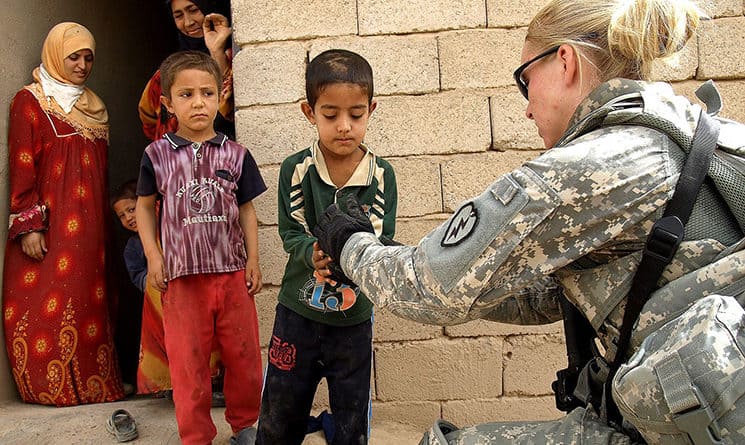An exhibit of combat photojournalism shows the realities of war
By Larry Clow, photos by Nathan Webster
The wars in Afghanistan and Iraq lasted some 13 years — and even though formal combat operations are over, American troops remain in both countries. The wars and the toll they took are very real for the soldiers who fought and the civilians who lived through them. But, for many Americans, as the years went on, the conflicts became something in the background, more abstract than concrete.
Nathan Webster, a photojournalist and a lecturer in the University of New Hampshire’s English Department, looks at it this way: “(The wars) have been going on for 13 years. If you’re a freshman (at UNH), that’s your entire life,” he said. Even with a 24-hour news cycle and social media, more than a decade of conflict has reduced the wars to something mundane and vague.
“Conflict Zone,” a traveling exhibit of photos from the wars in Iraq and Afghanistan by civilian and military photojournalists, aims to change that. Now on view at the University Museum in the Dimond Library, the exhibit illustrates the breadth of the combat experience through 50 photographs by 30 photographers.
Sgt. Kent Dell takes a break in a bunkroom in Salman Pak, Iraq, July 2009.
Webster is one of the contributing photographers and helped bring the exhibit to UNH. An Army veteran who served in Iraq as part of Operation Desert Storm in the early 1990s, Webster returned to the country as an embedded freelance photojournalist in 2007. It initially began as a tribute to New York Times photographer Joao Silva, who lost both his legs in a landmine blast in Afghanistan in 2010. A year later, photojournalist Chris Hondros, whose work is featured in the exhibit, was killed in Libya, and the exhibit is now dedicated to him.
“I didn’t see a lot of local (newspaper) coverage of individual soldiers,” he said. His stories and photos appeared in publications across the country; one of his photos was chosen to be part of “Conflict Zone.”
“That’s the truth of it. That’s what it looks like. It’s not an uplifting, hurray, let’s wave the flag moment. It’s a violent time.”
— photojournalist Nathan Webster
In a gallery talk on Feb. 5, Webster said the exhibit is “not trying to change anybody’s mind.” Instead, it’s meant to cover the breadth of war and the reality of life in a country during wartime.
“That’s the truth of it. That’s what it looks like,” he said. “It’s not an uplifting, hurray, let’s wave the flag moment. It’s a violent time.”
There are photos of children playing soccer in the shadow of a bombed out building and a striking image of an American soldier sweeping for bombs in an Afghan forest while a woman sits nearby, collecting herbs. Other photos show the boredom that comes with war — one of Webster’s photos is of a pair of soldiers and an Iraqi policeman taking a break under a bridge. It’s a perfect example of the daily grind of conflict.
“You can tell that (the Iraqi policeman’s) hot, tired, aggravated, and annoyed. There’s nothing really going on. That’s what war looks like 99 percent of the time,” he said.
U.S. Soldiers and an Iraqi policeman rest under a bridge in Bayji, Iraq, July 2007.
But the exhibit is confrontational about the violence and terror of war. In one photo, an Army patrol discovers the bodies of four Iraqi men, all shot in the head and left in the middle of a garbage-strewn lot. The men had been kidnapped and killed because they were members of Iraq’s security forces. In another, American troops carry off a fellow soldier who’d been wounded by a landmine.
“Conflict Zone” also follows its subjects home. The costs of war continue to be paid long after soldiers leave the battlefield. In one photo, an Iraqi soldier who lost his leg in an explosion is tended to at home by his brother. A photo by Craig F. Walker, part of a 2012 Pulitzer Prize-winning series, shows a Marine veteran looking at his service records and weeping after his application for an apartment had been rejected.
The photos in “Conflict Zone” have appeared in newspapers, both in print and online. But Webster said that seeing them in a large format, up close, and without the distractions that come with looking at them on a website, gives them a greater impact.
“It confronts you in a much different way,” he said. “They’re meant to be dramatic and visceral.”
“Conflict Zone” is on view through March 6 at the University Museum, Dimond Library, level 1, at the University of New Hampshire in Durham. As part of the exhibit, on Feb. 26, Elliot Ackerman, author of “Green on Blue,” will discuss wartime photojournalism at the Memorial Union Building at UNH at 5 p.m.
At top of page: Specialist Amber Sellers distributes candy to children in Tarmiyah, Iraq,June 2008.

